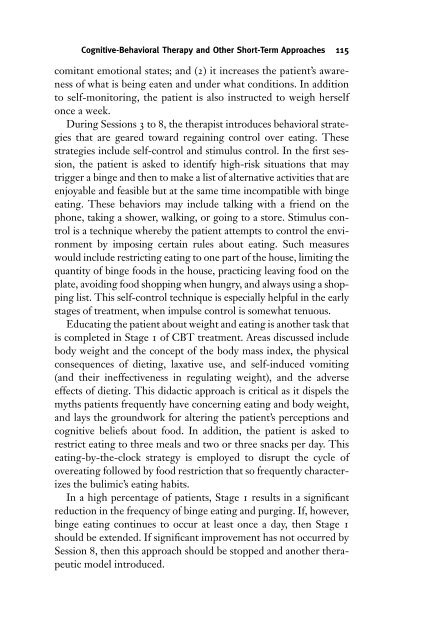Eating Disorders - fieldi
Eating Disorders - fieldi
Eating Disorders - fieldi
Create successful ePaper yourself
Turn your PDF publications into a flip-book with our unique Google optimized e-Paper software.
Cognitive-Behavioral Therapy and Other Short-Term Approaches 115<br />
comitant emotional states; and (2) it increases the patient’s awareness<br />
of what is being eaten and under what conditions. In addition<br />
to self-monitoring, the patient is also instructed to weigh herself<br />
once a week.<br />
During Sessions 3 to 8, the therapist introduces behavioral strategies<br />
that are geared toward regaining control over eating. These<br />
strategies include self-control and stimulus control. In the first session,<br />
the patient is asked to identify high-risk situations that may<br />
trigger a binge and then to make a list of alternative activities that are<br />
enjoyable and feasible but at the same time incompatible with binge<br />
eating. These behaviors may include talking with a friend on the<br />
phone, taking a shower, walking, or going to a store. Stimulus control<br />
is a technique whereby the patient attempts to control the environment<br />
by imposing certain rules about eating. Such measures<br />
would include restricting eating to one part of the house, limiting the<br />
quantity of binge foods in the house, practicing leaving food on the<br />
plate, avoiding food shopping when hungry, and always using a shopping<br />
list. This self-control technique is especially helpful in the early<br />
stages of treatment, when impulse control is somewhat tenuous.<br />
Educating the patient about weight and eating is another task that<br />
is completed in Stage 1 of CBT treatment. Areas discussed include<br />
body weight and the concept of the body mass index, the physical<br />
consequences of dieting, laxative use, and self-induced vomiting<br />
(and their ineffectiveness in regulating weight), and the adverse<br />
effects of dieting. This didactic approach is critical as it dispels the<br />
myths patients frequently have concerning eating and body weight,<br />
and lays the groundwork for altering the patient’s perceptions and<br />
cognitive beliefs about food. In addition, the patient is asked to<br />
restrict eating to three meals and two or three snacks per day. This<br />
eating-by-the-clock strategy is employed to disrupt the cycle of<br />
overeating followed by food restriction that so frequently characterizes<br />
the bulimic’s eating habits.<br />
In a high percentage of patients, Stage 1 results in a significant<br />
reduction in the frequency of binge eating and purging. If, however,<br />
binge eating continues to occur at least once a day, then Stage 1<br />
should be extended. If significant improvement has not occurred by<br />
Session 8, then this approach should be stopped and another therapeutic<br />
model introduced.









